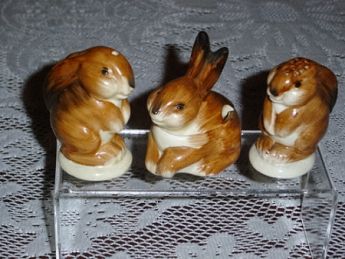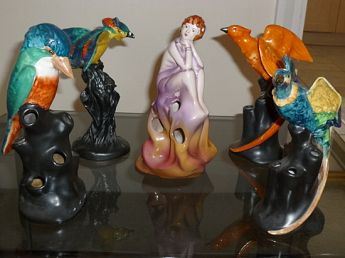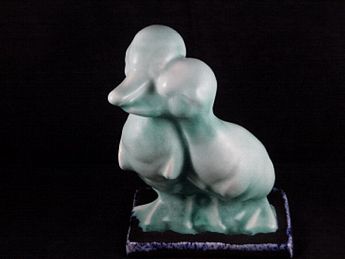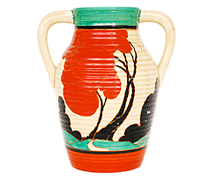Clarice Cliff Feature Articles
I am sure we all agree that there has been no other Staffordshire ceramic artist to match Clarice Cliff. Her glorious and prodigious output of both shapes and designs knows no equal. Her genius, however, was not limited to the sort of pottery that most people think of when her name is mentioned. Throughout her working life she produced works that required advanced modelling skills; to mention but a few - fancies, face masks, smokers sets, Age of Jazz figures, animals, birds, gollies, the Lido Lady ashtray.... the list is endless.
This article explores Clarice's life and achievements as a modeller. It has often been said that Clarice always considered herself a modeller first and designer second and we know that her love of modelling manifested itself early in life when her aunt used to bring home lumps of clay for the ten-year-old Clarice to play with.
We know from Clarice's Indentures, which turned up at an auction in 1996, that she was accepted as a modelling apprentice in September 1922. At the age of seventeen she joined A J Wilkinson’s in 1916 as a lithographer but from 1919 developed a lifelong friendship with Reg Lamb, who purloined special modelling clays for her from his department. We hear tales demonstrating her enthusiasm, taking clay home to model her sisters and many years later, a bust she had been working on of her sister Ethel was found in the basement in a disintegrated state. Early on, fellow workers recalled Clarice spending hours modelling close friends of Colley Shorter, who having noted her skills, commissioned her to do these including a bust of his father, Arthur Shorter, shortly after he died.
Evidence of Clarice's modelling skills was seen early. In 1924 when she modelled hand-made figurines such as the Orange and Pin Sellers and her Cottage bookends date from this period. In 1925, she modelled the Davenport range featuring bands of moulded fruit and birds wrapped round the tops of pieces which were then enamelled or gilded. Clarice was always a little bit different from her peers;dedicating her time to work and studying all the practical aspects of the pot bank. She was to put this knowledge to good use in future years when it came to the firing of particular shapes she had created. She had little time for socialising or going to dances and this set her apart from her fellow workers.
In her early years at Wilkinson’s, Clarice worked with John Butler, the Art Director, the position she was to make her own in later years. As well as improving her skills in enamelling, she continued to model items and it is worth remembering here that during this time, she was unique in the Potteries, as modelling was recognised as a male domain. She was also beginning to design patterns for her shapes! As time passed, she was given more responsibilities and her talents were sufficiently outstanding for her to be brought to the attention of owner, Colley Shorter. In 1922 these abilities were formally recognised when she began an apprenticeship as a modeller this having been personally ratified by Colley. It is interesting to note how valued she was by the company even then - as early as 1922 her wage increased to two guineas a week, this being seven years before the Bizarre years when the Girls would receive a weekly wage of six shillings.
During the years from 1922 onwards Clarice continued to gain experience with gilding and alongside learning various other skills, she honed her gift for modelling. The small hand-made figures made from solid clay date from this period including the Kingfisher and Heron models. The Girl Candlestick probably dates from around 1925.
In 1926, Colley gave Clarice her own studio at Newport Pottery which triggeredher immense outpouring of shapes and designs for her Bizarre range. However, she still continued to model various wares and adapted her life-like figures making them more stylised. The Girl Candlestick is a good example of her changing style and it was during this time that she produced the Mr and Mrs Duck and Hare series designed both as bookends and as ornaments; also the classic and very collectible Friday Night Ducks. When Clarice began her apprenticeship in 1922, very few fancies were being produced. This type of ware was limited and potteries tended to produce only what were called "seaside" novelties. Clarice had other ideas and a new vista rose on the horizon - she was to create a whole new market! Influenced by John Butler’s Arabian themes, Clarice produced the Seated Arab bookends and the Arab Boy candlestick. Other delightful modelling creations from this era are her various cruet sets, the Fish, her Cock-a-Doodle-Doo cruet, with a chick emerging from an egg as the mustard pot, and also her Rabbit cruets.
She produced other beautiful and functional items including her flower holders which came in all shapes and sizes including a charming swan. These flower holders are affectionately known as "frogs" and were intended to be placed into bowls with the holes holding flower stems erect to produce beautiful floral displays. The pottery already had a large range of more traditional realistically modelled bird flower frogs. One of Clarice’s additions was a young lady sitting on a rock. One piece which was not Clarice’s work however, was the Laughing Cat based on an original designed by Louis Wain. The early examples were aerographed in black but the Cliff versions have been humorously decorated in spots, or painted all over in orange! We also know that she produced many shapes for Shorter & Sons, the majority of which are not marked as her work, but are easily identified as her creations.
In March 1927 Clarice was sent to the Royal College of Art in Kensington (London) for two months during which time she had practice in modelling heads and figures from life and her tutor stated that "she has a natural facility as a modeller". Much of her modelling work after this time was in the form of stylised animals and as she gained confidence, she produced items such as the Golly, Teddy Bear and L'Oiseau bookends. These were being modelled at the same time as Original Bizarre was being produced. One of Clarice's many charming traits was her sense of humour and fun and this shines through in many of her pieces: to name but a few, her Friday Night Ducks, the Puddle Duck series, the Golly and Teddy bookends, the Laughing Cat, Chick Cocoa Pot and Age of Jazz figures.
In 1931 Clarice produced what are today a highly collectible series of figures called ‘the Impressions’. Although rarely seen, examples of these are housed at the Brighton Museum and were donated by Clarice for the Exhibition of her work held in 1972. They are full of humour and imagination, made entirely by hand with no moulds used and the range of colours used in the glazes makes them very desirable and collectible today.
From the middle of the thirties onwards, there appeared to be a "mood change” in Britain. Fashions were more subdued, and Clarice, who was always "tuned-in" to public needs and demands, responded to these varying tastes by creating new designs including moulded ware. She introduced more heavily embossed ranges such as My Garden, Raffia, Corncob, Harvest and Fruit and Basket. These needed several hours of skilful modelling and to assist her, she took on further apprentice modellers aged 15 and 16, including Betty Silvester, Nancy Greatrex and Peggy Gibbons. These girls had attended the Burslem School of Art in 1936/1937 and tended to stick together as they did not consider themselves to be "Bizarre Girls". Peggy Gibbons would go on to become a renowned modeller with Royal Doulton under her married name of Peggy Davies (but more about her later!).
By the end the War, Clarice had become one of the premier modellers of the times with an incredible 250 figurines plus to her credit. Fashions as always changed and during the late thirties Clarice modelled the more traditional items such as the Crinoline Lady Anne Wall Pocket dressed as an eighteenth century woman standing amidst trees, the Fish Wall Pocket, and the very plain Shell pocket.
It is also important to be aware that Clarice modelled several face masks (twenty six in all) which represented a significant part of her output. None of her competitors issued these in any quantity or with the same wonderful style: these were unique to Clarice. Being so innovative and representative of the thirties style, these are now highly prized by collectors. She even modelled smaller masks to be worn as pendants.
In June 1930, the Daily Mirror printed an article saying, "One of the romances of the pottery trade has been that of Miss Clarice Cliff who a short time back was a modeller for a pottery firm in Stoke before she conceived the idea of brighter pottery for the home. Now she spends her days designing many coloured fantasies that are painted on ordinary cream pottery by over 100 girls, ‘paintresses’ as they are called locally, who quickly learn her designs by heart"…….but she still continued with her modelling!
Clarice emerged as one of the most important ceramic modellers and designers in the Staffordshire Potteries during the thirties and her ware lit up what was a sad and depressed society at that time. It continues to shine its powerful beam today. We are fortunate that many of her totally unique creations, her diverse styles and prolific output during the years from 1922 to 1939 are still with us today, to hold us in thrall and give constant pleasure and joy to people the world over.
Thank you Clarice for giving and leaving us this legacy of your genius.
To end on a cheerful note, it was not always work and no play for Clarice's Girls. Modeller Peggy Gibbons, who gained fame as Peggy Davies after she married, occasionally worked together with our much-loved Bizarre Girl Edna Cheetham, who is still alive and well and living in St Ives. One day Clarice surprised them both by sending them on a painting demonstration to Lawleys in Dundee. Edna tells the tale of how, being young and naive and in a rather "wicked city" they visited the local lifeboat station on their day off. There they met and no doubt flirted with the crew. Imagine their surprise and consternation when these "big burly Scotsmen" turned up at Lawleys the following day to say "hello" and watch their demonstration. Although the girls probably loved the attention, needless to say, Lawleys staff were horrified! Edna and Peggy were whisked off to the supervisor, no doubt to get a rap over the knuckles. I wonder what Clarice had to say about it on their return?
PEGGY WILSON
Edited by Doreen Mann
· N.B. The story of Clarice Cliff 1925 Victorian Lady figurine discovered by Maureen and Harold Woodworth which has been deliberately omitted from here, will be told at another time.
The photograph of the Davenport vase is by courtesy of Mel Bryan.









